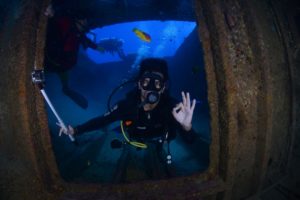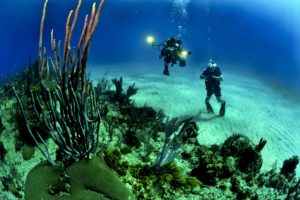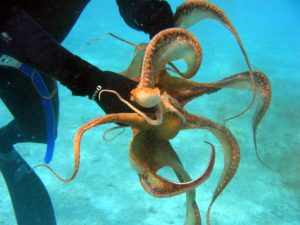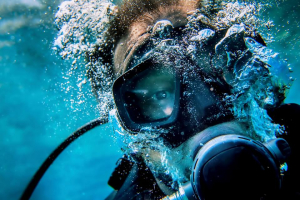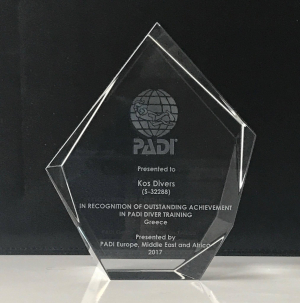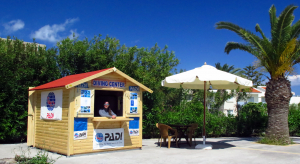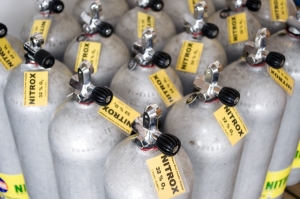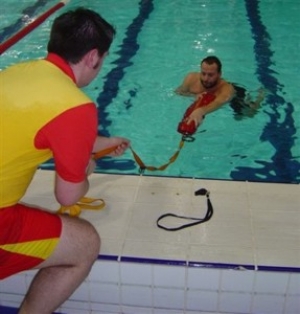Kostas Marmarinos
as normal
Kos island and Kos Divers are open and functioning as normal. As always the news reports exaggerate everything…
10 lies divers tell themselves
Usually a little white lie won’t hurt you, but these 10 lies scuba divers tell themselves can inflict some serious damage. Be honest and stop the tiny voice in your head from convincing you everything is fine when it’s not. If you’re not well enough for a dive, are in over your head (pun intended), or are facing any other number of factors that might keep you from diving safely, it’s best to just admit it and dive another day. Here are 10 situations you should address honestly.
I don’t need to brush up on my skills.
If you’ve been diving for years, a refresher may seem silly, even if you haven’t been underwater for a while. However, dive skills decay in as little as six months. While the experts advocate taking an official refresher course, at the very least, sharpen your skills during your first dive in shallow water one-on-one with an expert. Worst case, you spent a little money, enjoyed an easy dive and improved your technique in short order.
I’m fit enough to dive.
You don’t have to be thin or young to dive, but it’s critical to remain fit. We all get complacent, but if you’ll be splashing into the water soon, strengthen your cardiovascular health with regular exercise. Improved air consumption and stamina safeguards you and your dive buddies against any issues that arise.
I can have that third beer or cocktail.
We all love relaxing with dive buddies over an icy beverage, but the dangers of post-dive drinking (or drinking in between dives) exist. According to naui.org, “alcohol is associated with increased risk of decompression sickness, nitrogen narcosis and hypothermia/hyperthermia. [It also] further increases the risk of dehydration following the dive and may mask the signs and symptoms of decompression illnesses.” Enjoy an alcoholic beverage or two after your dives, but no diving the next day if you imbibe more. And as soon as you consume even one drink, you should cease all diving that day.
I can enter that wreck, cavern or the mouth of that cave.
Even with a big, light-filled space to swim through or the DM egging you on, any of these situations can instantly turn deadly without the proper training. Either avoid these scenarios altogether or obtain wreck/cavern certification to prevent issues and learn how to handle potentially dangerous situations.
I’m not over-weighted.
Most divers carry excess weight. It’s nice to sink down quickly from the surface, but extra weight means you’ll expend more effort while swimming, struggle to maintain neutral buoyancy, and possibly face issues when surfacing. Perform a pre-dive buoyancy check and consistently work to reduce the weight you haul.
I’m streamlined.
Divers commonly trail their gear under them, which represents a hazard for the diver and delicate coral. Improve your streamlining, and then ask a buddy to review you underwater and point out any issues you missed. You’ll decrease your air consumption with less drag in the water and prevent entanglements.
Kneeling on or touching the seafloor/sand/coral is acceptable.
You never know what’s underneath your knees, body or fins underwater. You could be crushing fragile marine life, get hurt or stir up the substrate for your fellow divers. And there’s no reason for it. With a little practice, buoyancy control becomes effortless.
I don’t need to take my gear with me.
Lugging gear around is annoying, but that’s your life-support equipment. Even on a trip where you’ll only be diving a few times, bring your gear. You’ll be unfamiliar with the rental gear during an emergency, and other divers may have treated it poorly. Those extra pounds in your suitcase are worth the weight and many airlines offer a larger weight/case allowance for sports equipment.
It’s okay to touch/harass wildlife or watch an “expert” do it.
You can injure some marine life with a single touch and it can also harm you. Forcing wildlife to interact may seem fun, but it embodies cruelty. For instance, compelling a porcupinefish to puff up or playing with an octopus causes them extreme stress. Keep your distance from marine life and remind anyone you witness touching or interacting with underwater life — even an instructor — of our role as ocean ambassadors.
I don’t need to practice skills learned during Open Water certification.
Hopefully, you’ll never perform an emergency ascent in a life-or-death situation, but could you? If you don’t practice basic skills including mask clearing, regulator recovery, manually inflating your BCD and the emergency ascent at least a few times a year, you may not survive a life-threatening situation. Just let your buddy and the DM know before you practice. Also note that you can practice the emergency ascent by swimming horizontally.
source: Scuba Diver Life
Here are five of the worst scuba diving habits you should avoid
We all get complacent when it comes to diving, but we shouldn’t. Here are five of the worst scuba diving habits you should avoid.
We’ve all been guilty of cutting corners when it comes to diving, especially the more experienced we become. We abbreviate or skip buddy checks; we assume the air in our tanks is sound without checking. Some of these bad scuba diving habits are just sloppy, but some can lead to true danger. Here are five bad scuba diving habits and how to break them.
Skipping the buddy check
The name “buddy check” makes an important series of tasks sound far too friendly, almost like it’s just suggestion rather than a potential life-saving routine. Let’s call it what it is, however — a pre-dive safety check. If you can’t remember the various acronyms from your open-water course, just visualize a diver and run through your equipment from head to toe.
Does the BCD actually inflate and deflate? Are all the escape valves tightened? Is the air turned on? Are any pull-cords or dumping strings trapped? Do you know how to operate all the fasteners and clips and how to remove the jacket quickly after a dive?
If you’re wearing a weight belt, is on properly? Are your integrated weight pockets snapped securely into your jacket if that’s your system?
You can get five breaths from a regulator when the tank is turned off. Do you only press the purge buttons and listen to the hissing sound, or do you look at your pressure gauge and breathe from the second stage? Ensure that your air is on every time, and make the buddy check count rather than just going through the motions.
Removing your mask and/or regulator upon surfacing
Most of us want to talk as soon as we reach the surface, and why not? You’ve just seen a whale shark and a couple of mantas! When we arrive at the surface though, we should delay our impulse to chat until we’ve inflated our jackets, signaled OK to the boat and made sure everyone in our party is also okay.
It’s all too easy to whip off your mask and take out your reg, only to get a face and mouth full of salt water. In rough conditions the boat has a limited time to approach, stop, help you and your group on board and keep the craft stable. As the minutes tick by the risk of injury from rear decks, rolling ladders and other divers increase.
Keep your surface habits tight and polished by establishing positive buoyancy immediately, staying together and keeping an eye and an ear out for the guide. Approach the boat deliberately, with your mask and reg in place, and time your exit to avoid others or any hazardous pickups. Once you’re safely back on board, chat away.
Going too deep
During open-water training, we learn that depth amplifies nearly everything, especially the amount of air we consume.
Although the dive guide has set a maximum depth of 82 feet (25 m), the group stays at 75 feet (23 m). Because you don’t yet have your buoyancy under control, you stray to 92 feet (28 m) where you swim, to the annoyance of others, for 15 minutes. Although you argue that it’s only 16 feet (5 m), you’ll be consuming more air than everyone else and cutting their dive short as well, so don’t make it a habit to go deeper than a planned dive profile
You’ll improve your buoyancy and air consumption through correct weighting and trim, and by reducing the energy you spend underwater.
Not analyzing your tanks
The boat is late leaving the jetty and the nitrox analyzer has a flat battery. Ahead of you is a trip to a shipwreck at 98 feet (30 m). Although you and your buddy were planning to dive on 32 percent nitrox, the guide tells you you’ll have to dive on air with everyone else, as the dive boat is in danger of missing the light.
But since you’ve been diving nitrox all week, you’re sure the nitrox tank you grab will be fine. It’s been reading 32 percent every time, and the guide is probably being overly cautious. So you turn the green and yellow content sticker around and hide it under the wide strap of your BCD. You decide to use the tank without analyzing it. You’ll gain a few extra minutes of bottom time and, just in case, you can always do an extra-long safety stop.
Inside the wreck at 91 feet (28 m) your vision distorts and your face muscles twitch. The taste in your mouth is sweet, slightly sugary even. Something is wrong — you turn to your buddy but he’s shaking uncontrollably with a convulsion. You have only one thought: What’s in our tanks?
You quickly grab him and hoist him towards the surface, stopping half way as he returns to consciousness. You’re at 52 feet (16 m) but you want to abort the dive. The guide spots you from below; you point to your ear. He lets you go and continues with the group.
Back on board, you quickly swap tanks, and grab a seat to calm down. Your buddy has a slight chest pain but nothing too much. A zodiac appears alongside the moored-up dive boat. The on board guide recognizes a friend and asks to borrow the zodiac’s nitrox analyzer.
He opens one of the nitrox tanks, places the sensor over the valve, and watches in astonishment as the digital display climbs to 50 percent.
The moral of the story: always check your tanks, and always watch the digital display yourself. A few extra minutes of bottom time isn’t worth the risk.
Not paying attention to the rules
There are four laws in scuba diving: Boyle’s, Dalton’s, Charles’s and…Murphy’s. The latter is the one most violated by scuba divers and the biggest cause of instant karma. Forget your camera and you’ll see a whale shark. Rush your pre-dive safety check, and you’ll drop your belt in the water. The list goes on.
Problems arise when you ignore the little voice in your head telling you to slow down as you unzip your bag, assemble your gear and prepare for your dive. In technical diving courses, I become that voice. I watch my students and steer them toward blunder just to test their knowledge of the rules. Take your time when you’re gearing up for a dive, and make sure you’ve crossed the Ts and dotted the Is.
BY GUEST AUTHOR JOHN KEAN
John Kean is the author of four books. He holds the PADI Master Instructor rating, along with TDI’s Advanced Trimix Instructor qualification. Since 1997 he has amassed over 7,000 dives, trained over 2,000 students and project-managed several world record deep dive events.
published in Scuba diver life
web offers pricing
Website pricing and offers are subject to change without notice and are based on the availability. So please proceed your online booking if you want to earn the present discounts! Thank you all
New info kiosk at Kipriotis Village
Visit our new info kiosk at Kipriotis village just opossite the old one, behind the amphitheatre next to the towel kiosk.
What is the Refund policy / terms and conditions?
Please check our Refund Policy, terms and conditions here https://www.kosdivers.com/terms-conditions
RECREATIONAL SPORT DIVER EQUIVALENCES FROM DIVE TRAINING AGENCIES, PADI, SSI AND SDI
by Lauren Kieren:
Have you ever found yourself wondering if an SDI course is equal (or equivalent) to courses offered by other dive training organizations?
Maybe you were asked to show verification of an “advanced diver” rating but you are unsure if your certification matches what the dive center is looking for.
If these situations sound familiar, this blog post is for you!
While each dive training organization strives to produce great divers, sometimes we use different terminology to say the same thing. Understanding equivalent ratings will allow you to see where your certification lines up with other organizations. In addition, it will allow you to know if you meet the prerequisites for a course if you hold a certification with one dive training organization then take a subsequent course with another.
Recently, we have received an influx of calls and e-mails requesting confirmation on equivalent ratings offered by multiple organizations. As a result, we put together an equivalency table of ratings offered by three agencies listed within the WRSTC: SDI (Scuba Diving International), SSI (Scuba Schools International), and PADI (Professional Association of Diving Instructors).
At the top of the chart you will find each dive training organization, and the certifications for that organization below it. You can quickly cross-reference a rating between dive training organizations; in the event a certification listed is not equivalent to the other organizations, the field will simply list “not applicable.”
COMPARE DIVER COURSES WITH THIS EQUIVALENCY CHART (PADI, SDI, SSI)
 |
 |
 |
| Skin Diver | Snorkeler | Snorkel Diver |
| Discover Scuba Diver | Scuba Discovery | TRY SCUBA DIVING |
| Bubble Maker | Future Buddies | Scuba Rangers |
| ReActivate™ – Scuba Refresher | Inactive Diver / Refresher | Scuba Skills Update |
| Not Applicable | Shallow Water Diver | Not Applicable |
| Not Applicable | Supervised Diver | Not Applicable |
| Scuba Diver | Not Applicable | Scuba Diver |
| Open Water Diver | Open Water Scuba Diver | Open Water Diver |
| Not Applicable | Advanced Diver | Advanced Open Water Diver |
| Rescue Diver | Rescue Diver | Diver Stress & Rescue |
| Master Diver | Master Diver | Master Diver |
| Not Applicable | Scubility Diver | Classified Diver |
| Advanced Open Water Diver | Advanced Adventure Diver | Advanced Adventurer |
| Peak Performance Buoyancy | Advanced Buoyancy Control | Perfect Buoyancy |
| Altitude Diver | Altitude Diver | Altitude Diving |
| Aware – Fish Identification | Marine Ecosystems Awareness Diver | Not Applicable |
| Aware – Coral Reef Conservation Diver | Marine Ecosystems Awareness Diver | Not Applicable |
| Boat Diver | Boat Diver | Boat Diving |
| Cavern Diver | TDI Cavern Diver | Extended Range (XR) Cavern Diving |
| Multilevel Diver | Computer Diver | Not Applicable |
| Enriched Air Diver | Computer Nitrox Diver | Enriched Air Nitrox Diver |
| EFR CPR & AED | CPROX 1st AED | REACT RIGHT |
| Deep Diver | Deep Diver | Deep Diving |
| Diver Propulsion Vehicle Diver | Diver Propulsion Vehicle | Not Applicable |
| Discover Rebreather | TDI Rebreather Discovery | Not Applicable |
| Drift Diver | Drift Diver | Not Applicable |
| Dry Suit Diver | Dry Suit Diver | Dry Suit Diving |
| Equipment Specialist | Equipment Specialist | Equipment Techniques |
| Not Applicable | Full Face Mask Diver | FFM |
| Ice Diver | Ice Diver | Ice Diver |
| Project AWARE® Specialist | Marine Ecosystems Awareness Diver | Ecology |
| Night Diver | Night/Limited Visibility Diver | Night & Limited Visibility |
| Not Applicable | Research Diver | Not Applicable |
| Search and Recovery Diver | Search and Recovery Diver | Search & Recovery |
| Not Applicable | Shore/Beach Diver | Waves, Tides, & Current |
| Sidemount Diver | Sidemount Diver | Recreational Sidemount Diving |
| Self Reliant Diver | Solo Diver | Independent Diver |
| Rebreather Diver | Not Applicable | Rebreather Diver |
| Not Applicable | UW Hunter and Collector | Not Applicable |
| Underwater Nagivator | UW Navigation Diver | Navigation |
| Digital Underwater Photography | UW Photographer | Underwater Photography |
| Underwater Videographer | UW Videographer | Not Applicable |
| Not Applicable | Visual Inspection Procedures | Not Applicable |
| Wreck Diver | Wreck Diver | Wreck Diver |
| Distinctive Specialties | Unique Specialties | Additional Specialties |
| Aware – Shark Conservation Diver | Shark Diver | Shark Diver |
| Invasive Lionfish Tracker | Lionfish Eradification Diver | Not Applicable |
| Sea Turtle Awareness | Turtle Awareness Diver | Not Applicable |
| Whale Shark Awareness | Not Applicable | Not Applicable |
| PADI Free Diver | Not Applicable | Basic Free Diver |
| Not Applicable | Goliath Grouper Awareness Diver | Not Applicable |
| Not Applicable | SDI Fill Station Operator | Not Applicable |
| Not Applicable | Heritage Awareness Diver | Not Applicable |
| Not Applicable | Kayak Diver | Not Applicable |
| Not Applicable | Manatee Awareness Diver | Not Applicable |
| Not Applicable | River Diver | River Diver |
It is recommended to all SDI, TDI, and ERDI instructors that they verify new students can demonstrate skills required in previous courses. As a result, if you are enrolling in an SDI, TDI, or ERDI course and coming from another organization you may be required to do a check-out dive with your instructor to verify that your skills and knowledgebase line up appropriately for the course, prior to commencement of training. We also recommend divers take a refresher course after a period of not diving, this period, while not a hard and fast rule, is about a year. This simply means that even though you hold a certification it is always a good idea to go on a dive with a professional and refresh your knowledge and skills.
All information is current at the time of publication. Over time, as organizations update their standards and create new courses, the information in this table may become outdated and is subject to change without any given notice. With that said, please do not copy or take screen captures of this table, as it may not be accurate in the future.
Regardless of the dive training organization you choose, we hope you have a wonderful dive experience and continue advancing your dive education in the future.
For a list of courses offered by SDI, including their Standards, click here! Also, if you are looking for your nearest SDI Dive Center, check out the SDI Dive Center Locater.
If you do not see your dive training organization on this list and you are curious if it’s equivalent to an SDI, TDI, or ERDI rating, let us know! Simply write a message to the training department ([email protected]) and we will be happy to help.
ARE YOU A PROFESSIONAL DIVER?
See our Accepted Professional Crossovers here!
Should you have any questions, feel free to ask us below.
Nitrox diving for beginners
By Jessica Mcdonald for Scuba diver life
As an instructor, I’ve found myself correcting countless students who are under the impression that nitrox enables a person to dive deeper than normal air — just one of the common misconceptions about nitrox diving. Although specific training is required before diving nitrox for the first time, these basic facts will help to make more sense of what it is and what it can do for you.
What is nitrox diving?
Quite literally, nitrox refers to a mix of nitrogen and oxygen, regardless of the percentage of each in the mix. The nitrox we use while diving is more properly called enriched-air nitrox, and refers to any blend of nitrogen and oxygen in which the oxygen concentration is greater than that of normal air. This means an oxygen level of 22 percent or higher, although the most common enriched-air nitrox blend is 32 percent. The recreational diving limit is 40 percent oxygen.
What does it do?
As every entry-level diver knows, increased pressure at depth causes the nitrogen in the air we breathe to be dissolved into the bloodstream. The time that we can spend underwater is limited by this nitrogen absorption — as we dive deeper and for longer, we absorb more nitrogen at a greater rate. Our no-decompression limit correlates to the amount of nitrogen our bodies can absorb before we must perform compulsory decompression stops or suffer the consequences of decompression sickness.
Enriched-air nitrox slows down the rate at which nitrogen dissolves into our bloodstream, because there is less nitrogen available to be absorbed from the mix that we’re breathing. The higher the percentage of your enriched-air blend, the more nitrogen is replaced with extra oxygen.
Benefits
There are several reasons divers use enriched-air nitrox. One of its biggest benefits is an increased no-decompression limit, which means longer bottom time. The lower percentage of nitrogen in the nitrox you’re breathing means your bloodstream is also absorbing nitrogen more slowly. For example, on normal air a diver has a no-decompression limit of 50 minutes at 60 feet; using a 36 percent enriched-air mix at the same depth will extend this limit to 130 minutes. In terms of increasing bottom time, enriched air is most useful for depths between 50 and 100 feet; any shallower and no-decompression limits are already so long that divers usually have no need to extend them.
Surface intervals are usually shorter on nitrox as well. Since there is less nitrogen to off-gas, a diver on enriched air will be able to re-enter the water sooner than a diver using normal air after completing the same profile. This also means that divers using enriched air typically have longer maximum bottom times on repetitive dives, and less off-gassing means that enriched air divers are often less tired at the end of the day than divers using normal air. Enriched air can be a valuable safety buffer for divers who choose to use it while following normal air tables, computers, profiles and procedures. Doing so creates a considerable conservative margin that further reduces the risk of decompression sickness, and may be advisable for anyone who may be susceptible to it, such as those who are tired, overweight, older, have suffered decompression sickness before, or are diving with injuries.
Myths, considerations and dangers
Although the benefits of diving with enriched air are significant, doing so also involves certain risks. One of the most common misconceptions about enriched air nitrox is that users can dive deeper than with normal air; in fact the opposite is true. Under pressure, oxygen becomes toxic. The percentage of oxygen in normal air (21 percent) only becomes toxic at depths greater than the recreational limit, but the increased percentages of oxygen in enriched air mean that toxicity can become a problem at much shallower depths. Toxicity causes convulsions that put a diver at risk of losing his regulator and subsequently drowning. However, enriched-air courses teach divers how to work out their maximum operating depth using the percentage and partial pressure of the oxygen in their mix. As long as the maximum operating depth is adhered to, oxygen toxicity should not be a problem.
Although standard scuba equipment is safe to use with air blends containing up to 40 percent oxygen, the process by which an enriched-air cylinder is filled often involves much higher concentrations. Partial-pressure blending exposes the cylinder to pure oxygen that is later diluted with normal air, and cylinders that are not treated for exposure to such high levels of oxygen can explode. Therefore, any part of the cylinder that comes in to contact with pure oxygen needs to be “oxygen clean,” and cylinders used for enriched air and normal air are not interchangeable. Enriched-air cylinders require decals or stickers to differentiate them from normal ones; they should be serviced annually.
There are a few other equipment considerations to bear in mind when considering enriched-air diving. Before each dive, you are personally responsible for checking the percentage of oxygen in your cylinder. If it is even slightly off, your maximum-operating depth calculations will be too. To check, you will need an analyzer, and although you can usually borrow one from your dive center, it’s a good idea to have your own if you intend to dive nitrox regularly. If you dive with a computer, you need to make sure that yours has enriched-air settings and correlates to the details of your mix before beginning each dive. Remember that enriched air does not improve air consumption, and neither does it give immunity to decompression sickness. Continue to check your gauges, depth and time limits as often as you would when diving on normal air.
With these precautions and the necessary training, enriched-air diving is a fantastic way to get the most out of your diving experience. You’ll spend more time in the water, and less time waiting to get back in.
σεμινάριο πιστοποίησης ΕΠΟΠΤΩΝ ΑΣΦΑΛΕΙΑΣ ΚΟΛΥΜΒΗΤΙΚΩΝ ΔΕΞΑΜΕΝΩΝ
H Σχολή Ναυαγοσωστικής Κω Kos Divers διοργανώνει σεμινάριο πιστοποίησης ΕΠΟΠΤΩΝ ΑΣΦΑΛΕΙΑΣ ΚΟΛΥΜΒΗΤΙΚΩΝ ΔΕΞΑΜΕΝΩΝ στην εκπτωτική τιμή των 200 ευρώ αποκλειστικά για τον Απρίλιο. Τα μαθήματα θα γίνουν σε ολιγομελή τμήματα και σε ώρες και ημέρες που σας εξυπηρετούν. Η τιμή ισχύει ΜΟΝΟ για τον Απρίλιο. Για κρατήσεις on line https://www.kosdivers.com/scuba-diving/dan-courses/179-swimming-pool-seminar για πληροφορίες καλέστε στο 6932155422. Θα κρατηθεί σειρά προτεραιότητας.
Επίσης ΜΟΝΟ για τον Απρίλιο το σχολείο ΝΑΥΑΓΟΣΩΣΤΗΣ ΠΙΣΙΝΑΣ στην εκπτωτική τιμή των 400 ευρώ.
Σχολή Ναυαγοσωστικής Κω
Αριθμός Αδείας
01/2009
Αριθμός φακέλου 513.6/2013
Αριθμός Σχεδίου 1182
Εκδούσα Αρχή Λιμενική Αρχή Κω.




